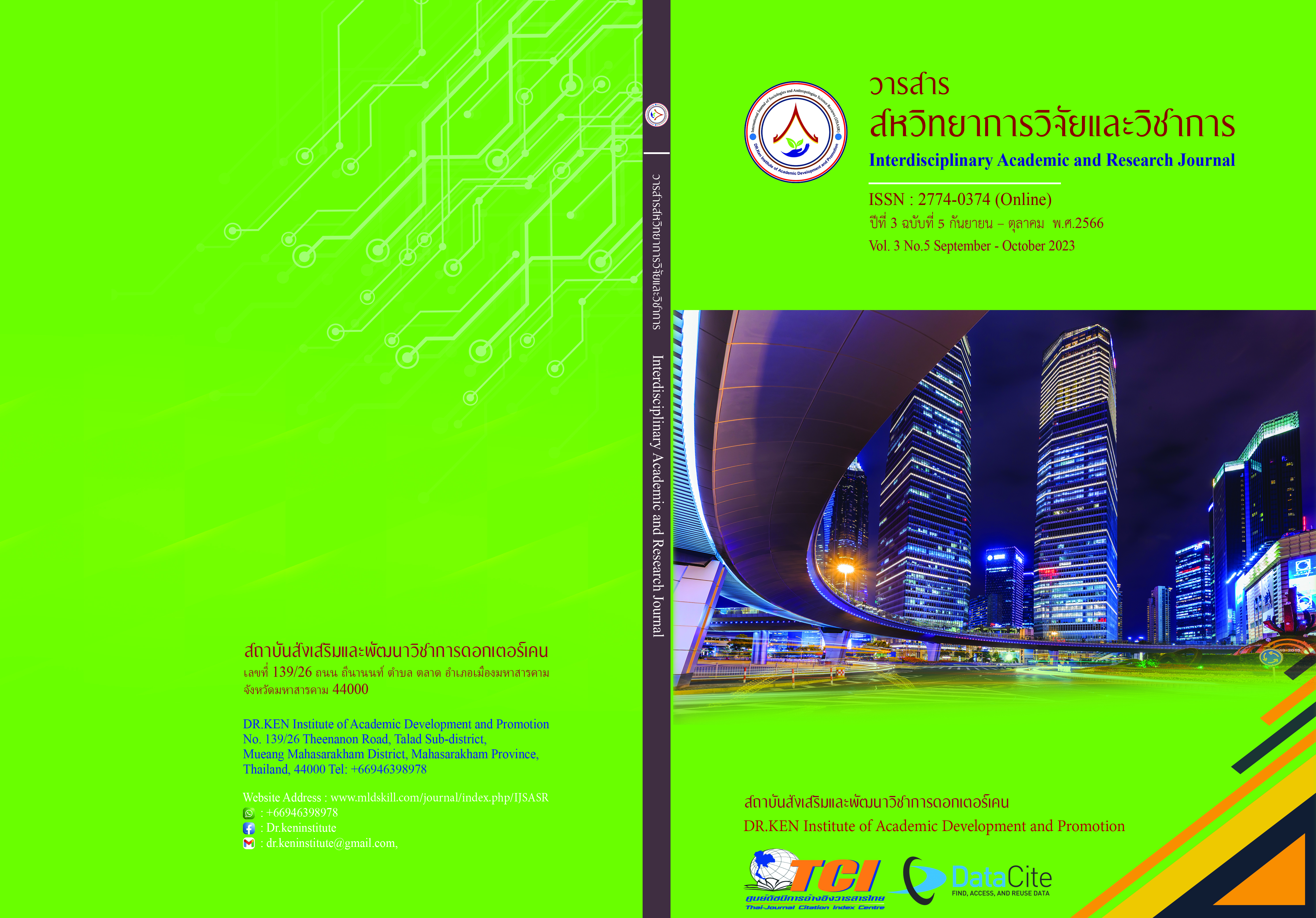Developing the Ability to Solve Mathematical Problems on Factorization of Polynomials of Mathayomsuksa 2 Students Using STAD Cooperative Learning Management Technique
DOI:
https://doi.org/10.14456/iarj.2023.285Keywords:
Development; , Problem-solving; , Mathematics; , Polynomial FactorizationAbstract
Mathematics is an important science in which the study of mathematics has the desired goals for the learners. Upon completion of the course, students will have knowledge and understanding of concepts, principles, and theories in mathematics that are essential and can be applied. Thus, the purposes of this research were 1) to develop a collaborative learning activity using the STAD technique on polynomial factorization; of Mathayomsuksa 2 students 2) to compare their ability to solve mathematical problems on polynomial factorization 3) to study student satisfaction with learning by using STAD technique cooperative learning activities. Maha Sarakham Secondary Educational Service Area Office, semester 2, academic year 2021, 40 students using group random sampling technique. The research tools were 1) a cooperative learning activity plan, STAD technique, and 2) a mathematical problem-solving ability test. subjective with a discriminant power between 0.35 - 0.62 and the results of the analysis of difficulty (P) between 0.38 - 0.71, the reliability of the whole paper was .94. 3) Satisfaction questionnaire with a 5-point rating scale. Statistics used in data analysis were mean, percentage, standard deviation, and Dependent Samples t-test. The research results were as follows: (1) The efficiency of the STAD cooperative learning activity on the polynomial factorization of Mathayomsuksa 2 students was 77.25/77.83, higher than the criteria of 70/70 set. (2) Ability to solve mathematical problems on the polynomial factorization of Mathayomsuksa 2 students using STAD cooperative learning activities after learning was higher than before at the statistical significance at the .05 level, and (3) the analysis of student satisfaction questionnaires by using STAD cooperative learning activities on polynomial factorization Mathayomsuksa 2 level was at a high level.
References
กระทรวงศึกษาธิการ. (2560). ตัวชี้วัดและสาระการเรียนรู้แกนกลางกลุ่มสาระการเรียนรู้คณิตศาสตร์ (ฉบับปรับปรุง พ.ศ. 2560) ตามหลักสูตรแกนกลางการศึกษาขั้นพื้นฐานพุทธศักราช 2551. กรุงเทพมหานคร : ชุมนุมสหกรณ์การเกษตรแห่งประเทศไทย.
แคทรียา ใจมูล. (2550). ผลการจัดการเรียนรู้โดยใช้เทคนิค STAD ในกลุ่มสาระการเรียนรู้คณิตศาสตร์ เรื่อง อัตราส่วนและร้อยละ ชั้นมัธยมศึกษาปีที่ 2 โรงเรียนห้วยส้านยาววิทยาสำนักงานเขตพื้นที่การศึกษาเชียงราย เขต 2. วิทยานิพนธ์ศึกษาศาสตรมหาบัณฑิต. เชียงราย : มหาวิยาลัยราชภัฎเชียงราย.
จิราพร กำจัดทุกข์. (2552). ความพึงพอใจหลังการตัดสินใจซื้อคอนโดมิเนียมในเขตกรุงเทพมหานคร. วิทยานิพนธ์วิทยาศาสตร์มหาบัณฑิต. กรุงเทพฯ : สถาบันบัณฑิตพัฒนบริหารศาสตร์.
ถวัลย์ มาศจรัส. (2550). นวัตกรรมทางการศึกษา. กรุงเทพมหานคร: ธารอักษร.
บัวรัตน์ แสงนาโก. (2555). พัฒนาการจัดการเรียนรู้ด้วยกลุ่มร่วมมือแบบ STAD กลุ่มสาระการเรียนรู้คณิตศาสตร์ เรื่อง สมการเชิงเส้นตัวแปรเดียว ชั้นมัธยมศึกษาปีที่ 1. วิทยานิพนธ์การศึกษามหาบัณฑิต. มหาสารคาม: มหาวิทยาลัยมหาสารคาม.
ปิยะธิดา ปัญญา. (2562). สถิติสำหรับการวิจัย. มหาสารคาม: ตักสิลาการพิมพ์.
พิชยาพร ราชคำ. (2563). การพัฒนากิจกรรมการเรียนรู้คณิตศาสตร์ตามแนวคิดห้องเรียนกลับด้านร่วมกับการเรียนรู้แบบร่วมมือรูปแบบ STAD เรื่อง พหุนามและการแยกตัวประกอบของพหุนามดีกรีสอง สำหรับนักเรียนชั้นมัธยมศึกษาปีที่ 2. วิทยานิพนธ์ครุศาสตรมหาบัณฑิต. สกลนคร : มหาวิทยาลัยราชภัฏสกลนคร.
ไพศาล วรคำ. (2562). การวิจัยทางการศึกษา. (พิมพ์ครั้งที่ 10). มหาสารคาม: ตักสิลาการพิมพ์.
ภาไฉน เข็มเพ็ชร. (2547). การสร้างแผนการจัดการเรียนรู้ เรื่องพื้นที่ผิวและปริมาตรโดยใช้กิจกรรมการเรียนรู้ตามรูปแบบ เอส ทีเอ ดี ระดับชั้นมัธยมศึกษาปีที่3. ปริญญาศึกษาศาสตรมหาบัณฑิต. เชียงใหม่ : มหาวิทยาลัยเชียงใหม่.
โรงเรียนนาเชือกพิทยาสรรค์. (2565). ผลสัมฤทธิ์ทางการเรียนของนักเรียนโรงเรียนนาเชือกพิทยาสรรค์ ปี 2562 - 2564. มหาสารคาม.
ลัดดา เชื้อฉ่ำหลวง. (2561). การพัฒนากิจกรรมการเรียนรู้คณิตศาสตร์ เรื่อง การแยกตัวประกอบของพหุนาม ดีกรีสอง โดยใช้รูปแบบการสอนแบบร่วมมือกันเรียนรู้เทคนิค S. Retrieved on February 4, 2021, from: https://www.kroobannok.com/board_view.php?b_id=175921.
วนัญชนา เชิงดี. (2555). การพัฒนาการแก้โจทย์ปัญหาคณิตศาสตร์ โดยใช้วิธีการแบบเปิดสำหรับนักเรียนชั้นมัธยมศึกษาปีที่ 2. วิทยานิพนธ์ปริญญามหาบัณฑิต. ปทุมธานี : มหาวิทยาลัยเทคโนโลยีราชมงคลธัญบุรี.
สถาบันส่งเสริมการสอนวิทยาศาสตร์และเทคโนโลยี (สสวท.). (2560). การจัดสาระการเรียนรู้กลุ่มวิทยาศาสตร์หลักสูตรการศึกษาขั้นพื้นฐาน. กรุงเทพฯ: สถาบันส่งเสริมการสอนวิทยาศาสตร์และเทคโนโลยี.
สถาบันส่งเสริมการสอนวิทยาศาสตร์และเทคโนโลยี. (2561). หนังสือเรียนรายวิชาพื้นฐานวิทยาศาสตร์ ชั้นมัธยมศึกษาปีที่ 1 เล่ม 2 ตามมาตรฐานการเรียนรู้และตัวชี้วัด กลุ่มสาระการเรียนรู้วิทยาศาสตร์ (ฉบับปรับปรุง พ.ศ. 2560). กรุงเทพมหานคร: โรงพิมพ์สกสค. ลาดพร้าว.
สุคนธ์ สินธพานนท์ และคณะ. (2552). การจัดกระบวนการเรียนรู้ : เน้นผู้เรียนเป็นสำคัญ. กรุงเทพฯ : อักษรเจริญทัศน์.
สุนันท์ สังข์อ่อง. (2555). หลักสูตรและการสอนสาหรับศตวรรษที่21. เอกสารประกอบการสอนมหาวิทยาลัยธุรกิจบัณฑิตย์.
สุวิทย์ มูลคำ และอรทัย มูลคำ. (2547). เรียนรู้สู่ครูมืออาชีพ. พิมพ์ครั้งที่ 6. กรุงเทพฯ : ดวงกมลสมัย.
สุวิทย์ มูลคำ และอรทัย มูลคำ. (2552). 19 วิธีจัดการเรียนรู้ : เพื่อพัฒนาความรู้และทักษะ. กรุงเทพฯ : ภาพพิมพ์.
สุวิทย์ มูลคำ. (2547). ครบเครื่องเรื่องการคิด. พิมพ์ครั้งที่ 3. กรุงเทพฯ: ภาพพิมพ์.
Slavin, R.E. (1995). Cooperative learning: Theory, research, and practice. Boston: Allyn & Bacon.
Downloads
Published
How to Cite
Issue
Section
License
Copyright (c) 2023 Nattarud Arsapa, Nattachai Janthachum, Wanida Pharanat

This work is licensed under a Creative Commons Attribution-NonCommercial-NoDerivatives 4.0 International License.
Copyright on any article in the Interdisciplinary Academic and Research Journal is retained by the author(s) under the under the Creative Commons Attribution-NonCommercial-NoDerivatives 4.0 International License. Permission to use text, content, images, etc. of publication. Any user to read, download, copy, distribute, print, search, or link to the full texts of articles, crawl them for indexing, pass them as data to software, or use them for any other lawful purpose. But do not use it for commercial use or with the intent to benefit any business.
















.png)


